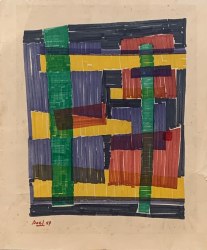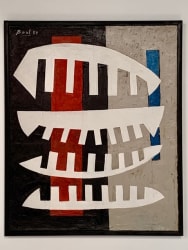Inloggen
Registreren
NL
Maurice Boel 1913 - 1998
Vertegenwoordigd door:
Callewaert Vanlangendonck Gallery
Maurice Boel studied at the Royal Academy in Brussels and at the Free Academy 'La Grande Chaumière' in Paris (1950).
He had an intense contact with James Ensor from an early age.
He was strongly influenced by Permeke's expressionism but evolved into a colorful, dreamy fantasy representation in which he used form combinations and overlapping structures. He left the figuration and gradually evolved into a geometric, lyrical abstraction with retention of color and rhythm. His works have a well thought-out structure with rhythmic vertical lines and irregular surfaces.
Maurice Boel held his first solo exhibition in 1938 in the gallery 'Studio' in Ostend. James Ensor, who was nevertheless known for his cynical behavior towards young talents, insisted on writing the introduction and praised him with all praise. He ended with the words "Boel, Boel, de Boel is good!" An art critic wrote as follows: 'He is a striver, he is a seeker. He lives through time, we can expect the best from him'.
On the intercession of Permeke and Queen Elisabeth he got the offer in 1947 to hold an exhibition in the Palais des Beaux-Arts (the current BOZAR), where he received praise from, among others, the painter Edgar Tytgat. In the same year he held an exhibition in the Kursaal of Ostend and at Zaal Pan in Ghent.
He left for Italy in 1960, had an exhibition in Florence together with Anne Dubois and worked in Rome at the Academia Belgica. In 1961 he gave an exhibition together with Camille De Taye and Jeanne Rucquoi. Later in the same year he exhibits his Italian works in the Kursaal in Ostend.
In 1966 he held his fifth exhibition at the Palais des Beaux-Arts in Brussels.
He had an intense contact with James Ensor from an early age.
He was strongly influenced by Permeke's expressionism but evolved into a colorful, dreamy fantasy representation in which he used form combinations and overlapping structures. He left the figuration and gradually evolved into a geometric, lyrical abstraction with retention of color and rhythm. His works have a well thought-out structure with rhythmic vertical lines and irregular surfaces.
Maurice Boel held his first solo exhibition in 1938 in the gallery 'Studio' in Ostend. James Ensor, who was nevertheless known for his cynical behavior towards young talents, insisted on writing the introduction and praised him with all praise. He ended with the words "Boel, Boel, de Boel is good!" An art critic wrote as follows: 'He is a striver, he is a seeker. He lives through time, we can expect the best from him'.
On the intercession of Permeke and Queen Elisabeth he got the offer in 1947 to hold an exhibition in the Palais des Beaux-Arts (the current BOZAR), where he received praise from, among others, the painter Edgar Tytgat. In the same year he held an exhibition in the Kursaal of Ostend and at Zaal Pan in Ghent.
He left for Italy in 1960, had an exhibition in Florence together with Anne Dubois and worked in Rome at the Academia Belgica. In 1961 he gave an exhibition together with Camille De Taye and Jeanne Rucquoi. Later in the same year he exhibits his Italian works in the Kursaal in Ostend.
In 1966 he held his fifth exhibition at the Palais des Beaux-Arts in Brussels.
Kunstwerken
Articles
Media
Highlights
Over de kunstenaar
In collectie van
Tentoonstellingen
Marktpositie
CV
Aangeboden kunstwerken van Maurice Boel
Gratis Online Magazine
Artikelen, interviews, shows & events. Wekelijks bezorgd in uw mailbox.






